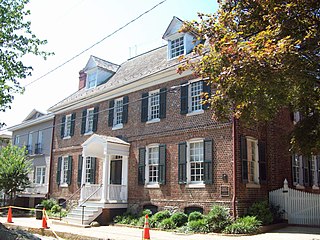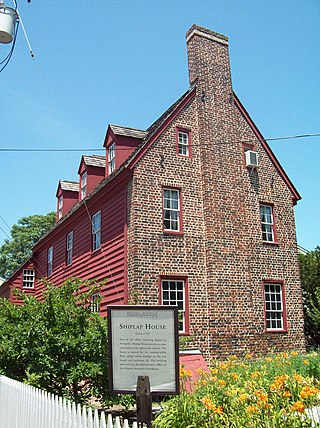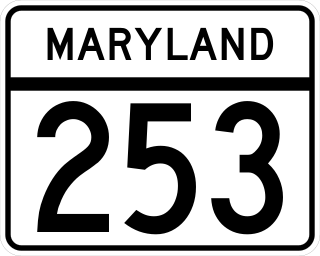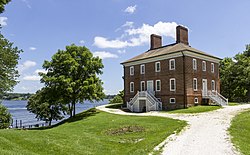
Londontowne is an unincorporated area and former census-designated place (CDP) in Anne Arundel County, Maryland, United States, and the site of a former colonial seaport founded on the South River in 1683. The population was 7,595 at the 2000 census. At the 2010 census, the area was delineated as the Edgewater CDP.
The South River is a 10-mile-long (16 km) tributary of the Chesapeake Bay in Anne Arundel County, Maryland in the United States. It lies south of the Severn River, east of the Patuxent River, and north of the West River and Rhode River, and drains to the Chesapeake Bay.

The Hammond–Harwood House is a historic house museum at 19 Maryland Avenue in Annapolis, Maryland, USA. Built in 1774, is one of the premier colonial houses remaining in America from the British colonial period (1607–1776). It is the only existing work of colonial academic architecture that was principally designed from a plate in Andrea Palladio's I Quattro Libri dell'Architettura (1570). The house was designed by the architect William Buckland in 1773–1774 for wealthy farmer Matthias Hammond of Anne Arundel County, Maryland. It was modeled on the design of the Villa Pisani in Montagnana, Italy, as depicted in Book II, Chapter XIV of Palladio's work. It was designated a National Historic Landmark in 1960, and is now managed by a non-profit organization as a museum.

The Belair Mansion, located in the historic Collington area and in Bowie, Maryland, United States, built c. 1745, is the Georgian style plantation house of Provincial Governor of Maryland, Samuel Ogle. Later home to another Maryland governor, the mansion is listed on the National Register of Historic Places.

Woodlands, or the William Gilmore Simms Estate, is a historic plantation estate in Bamberg County, South Carolina. The property is nationally notable as the home for many years of author William Gilmore Simms (1806-1870), considered one of the leading literary voices of the antebellum Southern United States, and was designated a National Historic Landmark in 1971. The main house, built in part by Simms, contains mementos from his period.

The William Trent House is a historic building located at 15 Market Street in Trenton, Mercer County, New Jersey. It was built in 1719 for William Trent and is the oldest building in Trenton. He founded the eponymous town, which became the capital of New Jersey. It has served as the residence for three Governors. The house was added to the National Register of Historic Places and listed as a National Historic Landmark on April 15, 1970, for its significance as an example of Early Georgian Colonial architecture.

The William Paca House is an 18th-century Georgian mansion in Annapolis, Maryland, United States. Founding Father William Paca was a signatory of the Declaration of Independence and a three-term Governor of Maryland. The house was built between 1763 and 1765 and its architecture was largely designed by Paca himself. The 2-acre (8,100 m2) walled garden, which includes a two-story summer house, has been restored to its original state.

The Brice House is, along with the Hammond-Harwood House and the William Paca House, one of three similar preserved 18th-century Georgian style brick houses in Annapolis, Maryland. Like the Paca and Hammond-Harwood houses, it is a five-part brick mansion with a large central block and flanking pavilions with connecting hyphens. Of the three, the Brice House's exterior is the most austere, giving its brickwork particular prominence. The Brice House was declared a National Historic Landmark in 1970.

The Chase–Lloyd House is a historic house at 22 Maryland Avenue in Annapolis, Maryland. Built in 1769–1774, it is one of the first brick three-story Georgian mansions to be built in the Thirteen Colonies, and is one of the finest examples of the style. Its interiors were designed by William Buckland.

Whitehall is a colonial home that was built beginning in 1764 near Annapolis in Anne Arundel County in the Province of Maryland by Horatio Sharpe, then the provincial governor of the British colony of Maryland.

Tulip Hill is a plantation house located about one mile from Galesville in Anne Arundel County in the Province of Maryland. Built between 1755 and 1756, it is a particularly fine example of an early Georgian mansion, and was designated a National Historic Landmark in 1970 for its architecture.

The Peggy Stewart House, also known as the Rutland-Jenifer-Stone House, is a Georgian-style house in Annapolis, Maryland. Built between 1761 and 1764 by Thomas Rutland as a rental property, it was owned at various times by Thomas Stone and U.S. Founding Father Daniel of St. Thomas Jenifer. In October 1774 it was owned by Anthony Stewart, owner of the ship Peggy Stewart. It was listed in the National Register of Historic Places in 1973 for its associations with the burning of Anthony Stewart's ship, Peggy Stewart, as well as for its architectural significance as a mid- to late 18th century Georgian mansion. Furthermore, the dwelling was recognized as a National Historic Landmark for its associations with Jenifer and Stone, and for the thematic representation of politics and diplomacy during the American Revolution

The Colonial Annapolis Historic District is a historic district in the City of Annapolis, the state capital of Maryland, that was designated a National Historic Landmark District in 1965 and was geographically further expanded in 1984.

Maidstone is an old southern Maryland plantation located in Owings, Calvert County, Maryland. The oldest extant part of the house was built in 1751 by a yeoman planter, Lewis Lewin on or near the site of an earlier wood structure., though a brick in one of the chimneys is dated 1678.

The Upton Scott House is a historic home in Annapolis, Anne Arundel County, Maryland, United States. It is a 2+1⁄2-story, rectangular brick house. The interior is lavish, and the house has sustained only minor alterations in the 20th century. The house was built for Dr. Upton Scott, the personal physician to the Royal Governor of the Province of Maryland, and is of the transitional Georgian style. The house was built by William Brown, and closely resembles Brown's house on the South River, now known as the London Town Publik House.

All Hallows Church, also known as The Brick Church, is a historic church located at 3604 Solomon's Island Road, in Edgewater, Anne Arundel County, Maryland, United States. Parish records date back to 1682, indicating that it existed prior to the Act of Establishment (1692) passed by the General Assembly of Maryland laying off the Province into 30 Anglican parishes.

The South River Club is a social club located just south of Annapolis in Anne Arundel County, Maryland. The name also refers to the group's clubhouse, which was built in 1742.

The Old City Hall and Engine House is a historic municipal building at Annapolis, Anne Arundel County, Maryland, United States. It is a 2+1⁄2-story, three bay brick building built 1821–1822 by the City of Annapolis. It was the first structure erected by the city for municipal purposes. On the first floor was the fire station, with a meeting room for the town council above. In 1868 the city sold the building for commercial purposes.
Woodland Beach is an unincorporated community in Anne Arundel County, Maryland, United States.

Maryland Route 253 is a state highway in the U.S. state of Maryland. Known as Mayo Road, the route runs 1.34 miles (2.16 km) from MD 214 north to MD 2 within Edgewater. MD 253 was constructed in Edgewater in the early 1910s and early 1920s. The highway was extended southeast through Mayo to Beverley Beach in the late 1920s and early 1930s. The part of MD 253 southeast of Edgewater became part of MD 214 in 1950.

























